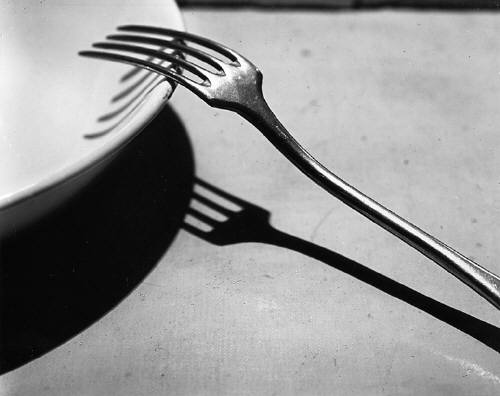My Best Print (Slightly Manipulated on Photoshop) - This print I feel was my best one. When I was doing these prints I had a hard time trying to capture the whites in the background and on my subjects face and at the same time trying to keep the contrasty blacks in the shadows and in her clothing. The thing that I do not like about using film is that you have to continuously use up paper and go back and forth from the machine to achieve an image that you are happy with: the upside of using digital being that you can change the settings in the palm of your hand, and if further needs to be done it can be done clearly on photoshop or on any editing programmes. However using film can be effective in refining your photography skills in more aspects, in this case: the dark room. I think that this photo was successful because, eventually, I did capture the white tones that were there somewhere. Also, the picture is well composed and pretty straight forward. I think that the composition that I have had my model doing was fairly natural and put her under no stress, making her feel more at ease and making this a nicer picture. The subject has nice eyes, and I think that I have successfully captured them and made them the main point of focus in this picture. This is done by the head light that is used to illuminate the subject, this is the glint in her eyes. I feel that this draws the viewer's attention straight towards them. One aspect of this photo which makes it similar to the portrait artist that we are covering at the moment (David Bailey), are the shadows created by the headlight to the left of the subject. This is similar Bailey's portrait of Jack Nicholson; a portrait we studied last lesson. Another image of Bailey's which I believe this photo is similar to is his portrait of super model Naomi Campbell. I think that my photo is similar to that one of his is because of the fact there has been contrasted shadows used, however they are not as strong as the ones in the Jack Nicholson shoot. I also believe that both photos are quite natural poses and the subjects seem more at ease. I edited this photo only slightly by using the healing brush and getting rid of some smudges that were on the film (see on original print underneath). I used a magenta filter in this print as well, like I did when developing my still life photos. This made the lines int he picture more defined and contrasty. Below, I have attached an David Bailey's photo of Naomi Campbell, an original print, one with different settings and two Photoshop manipulated images.
Settings of the Final Image:
Photo:
Focal Length - 35mm
Aperture - F5.6
Film IS0 - 400
Shutter Speed - 1/125
Developing for Final Print:
F Settings - F11
Timing - 05:00 seconds.
Filter? - Magenta, on, full strength.
|
The First Print (Not Manipulated on Photoshop) - There are several things about this photo that I was not happy about and needed further development. In this developed print there are too many dark tones which make it uneasy to look at and all in all an unattractive development of what otherwise would be a nicely composed and natural looking photograph. The settings I used in this were completely different to my final print. I used a more intense light for a shorter amount of time. In my final print I decided to opt for a less intense light for a longer amount of time. In this photo there are a few smudges also which I then went on to get rid of in photoshop for my final print. Something also about this picture which was bad was the black fringing on the top boarder. This was caused because, foolishly, I left my printing paper slightly exposed to light. This ruined all of my paper and left it with a horrible black fringe around the top. Because of this, I am going to have to use a new box of paper. This is a lesson to be learnt that I should be careful with my paper and ensure that it is not exposed to any light.
|
Developing the First Print:
F Setting - F8
Timing - 3 seconds
Filter? - None
|
My Photoshop Manipulated Images:
These two images have been tweaked slightly in CS5. The image on the right has had its levels changed, creating a more contrasty photo that seems to be more prominent on the paper. One thing that I have to be wary of about editing film photos on photoshop is that unlike when I do images and have the ability to be playing with large 14 megapixel photos, these are a very size and as such have a tendency to have banding (the strong tone differences around the subject's face). The one on the left is more subtle, I believe, because I did not edit is as much. The only editing done on this photo was sharpening and colour balance. Both images were 'sharpened more'.
 |
| Naomi Campbell by David Bailey http://4.bp.blogspot.com/_q08M1ajACHg/SGtYhIGOLLI/AAAAAAAACcU/qUk82rQ9bsU/s320/naomi.jpg |
Links to photos including photos not included in this post:
Posterised image - http://www.flickr.com/photos/luke_mellor/8211401394/in/photostream
Purple image - http://www.flickr.com/photos/luke_mellor/8210312865/in/photostream/
Final print - http://www.flickr.com/photos/luke_mellor/8210312999/in/photostream/
Unused image - http://www.flickr.com/photos/luke_mellor/8211401802/in/photostream/
Unused image - http://www.flickr.com/photos/luke_mellor/8211401926/in/photostream/
First print - http://www.flickr.com/photos/luke_mellor/8211402020/in/photostream/



















